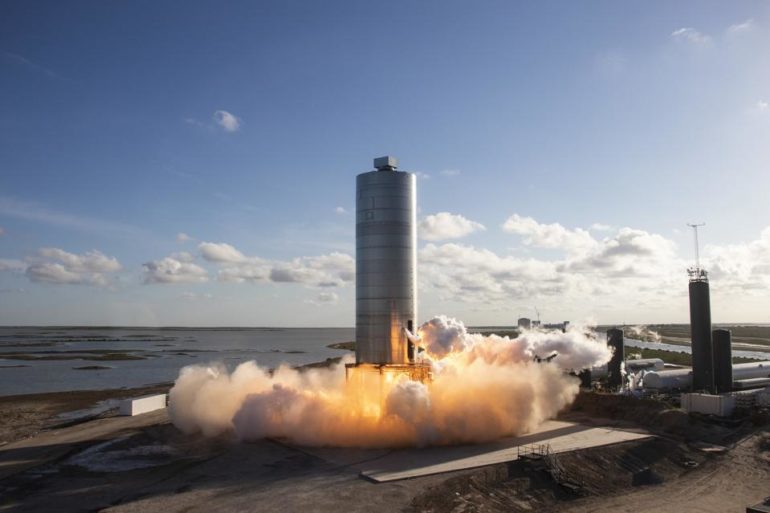Update: The launch was aborted at T – 1.3 seconds.
Original text: SpaceX is about to attempt its most ambitious test launch yet of Starship-Super Heavy, a fully reusable rocket system that may one day slash the cost of reaching space by 1,000-fold.
The aerospace company, founded by Elon Musk, aims to launch a three-engine, 16-story prototype of the Starship spaceship on Tuesday from its expanding facilities at Boca Chica, Texas, and you can watch any of several live video feeds below. (SpaceX is not yet ready to test a 23-story booster that would eventually help propel a spaceship to orbit.)
Musk tweeted on November 24 the plan is to fly the prototype – called Starship serial no. 8, or SN8 – up to 50,000 feet or 9.3 miles (15 kilometers).
However, SpaceX later lowered that ceiling to 41,000 feet or 7.8 miles (12.5 kilometers), according to Reuters.
Such a high-altitude flight attempt is the most ambitious yet for Starship. Musk said last week that a “lot of things need to go right” for SN8 to land intact, adding that he thinks there’s “maybe 1/3 chance” that it does.
The Federal Aviation Administration gave SpaceX between 8 am and 6 pm CT (9 am and 7 pm ET) to launch, according to an airspace closure notice.
“The schedule is dynamic and likely to change, as is the case with all development testing,” SpaceX said ahead of the launch attempt.
The exact time of planned liftoff isn’t publicly known. However, NASA’s high-altitude WB-57 jet took off from Houston at 3:11 pm CT and is scheduled to reach Boca Chica around 4 pm CT FlightAware.com.
That plane should be in position to record video of the launch around 4:15 pm CT. (NASA did not immediately respond to Business Insider’s request for comment.)
SpaceX plans to host a live broadcast of the attempt on YouTube starting a few minutes before liftoff. However, fans of the company are on the ground and streaming their own live video in the area. We recommend starting with NASASpaceflight’s video stream, embedded below, given the broadcasters’ knowledge and multiple quality camera views.
LabPadre offers different views and live commentary of SpaceX’s launch site via its livestream.
For a more distant view of the launch site, which is broadcast from the top of a hotel resort in South Padre Island about 6 miles away, check out SPadre’s 24-hour live feed.
Once SpaceX begins its own broadcast, typically with live views from flying drones, you can watch the company’s feed below.
https://www.youtube.com/watch?v=nf83yzzme2I
Based on prior Starship prototype flights, a series of events typically precedes launch. A couple of hours beforehand, SpaceX will clear the launch site of personnel. Roughly an hour ahead of flight, storage tanks at the launch site will begin venting gases as SpaceX prepares to fuel Starship with cryogenic fuels. That venting appeared to begin around 3:30 pm CT.
Fuelling later causes Starship to vent gases out of its top, signalling launch could occur within minutes.
SpaceX could try again Wednesday or Thursday at roughly the same times if any hiccups prevent launch. Poor weather, a technical glitch, or a boat entering the launch’s danger zone – a new challenge for Starship – could lead to delays.
What SpaceX hopes to accomplish with its most ambitious Starship launch yet
SpaceX is taking a rapid but incremental approach to proving Starship’s core systems function as designed, making tweaks where the system needs work, and getting it back to the launch pad for more testing.
SpaceX flew a “Starhopper” prototype to about 492 feet (150 meters) in 2019 and launched a larger SN5 prototype to a similar height this August. Those tests helped SpaceX test the system’s giant Raptor rocket engines and landing capability.
This week’s test flight is a big step in seeing whether SN8 can withstand the rigors of greater altitudes, speeds, and manoeuvres.
If all goes well, SN8 will lift off the pad and fade from view. As it reaches the apogee of its flight, the thrusters of a reaction-control system will tip the vehicle forward into a “belly flop” position. This will allow SpaceX to see how Starship’s canards and wing flaps perform as the vehicle careens back to Earth.
“SN8 will also attempt to perform a landing flip manoeuvre, which would be a first for a vehicle of this size,” SpaceX said in the description of its YouTube broadcast, adding that “success is not measured by completion of specific objectives but rather how much we can learn as a whole, which will inform and improve the probability of success in the future.”
SpaceX ultimately hopes to leave behind suborbital launch attempts and try rocketing Starships to orbit from Boca Chica. However, the company now faces a new environmental analysis with the FAA. Depending on how that process plays out, SpaceX may see a delay to orbit from a few months to a few years.
This article was originally published by Business Insider.
More from Business Insider:



